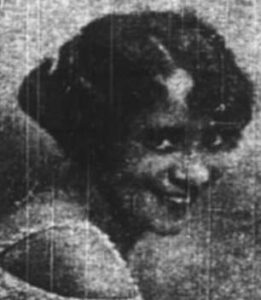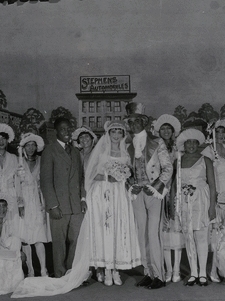YOUR DAILY DOSE OF EUBIE!!!!!
When Shuffle Along opened in May 1921, it was a surprise commercial and artistic success. The first musical comedy with a script, songs, and dance numbers written by African-Americans—and an all-black cast—Shuffle Along revolutionized the Broadway musical. It was the first musical to present Blacks as “real people”—going far beyond the popular minstrel stereotypes. And the star of the show was actress Lottie Gee—one of the most successful black singers and dancers of the era, having established herself both on the New York stage and abroad. Gee’s performance lit up the stage and her picture was splashed across newspapers around the country—both in the black and white press. But strangely after her immense success in Shuffle Along—which ran for over 500 performances in New York alone—Gee disappeared from theatrical history. Unlike other female stars who made their Broadway debuts in the show—including Gertrude Saunders, Florence Mills, and Josephine Baker–she never made a record, never appeared in a short film, and by the late ‘20s was virtually forgotten.

Born Charlotte M. Gee in Millboro, Virginia, on August 17, 1886, Gee worked her way up from chorus girl to leading lady. Gee made one of her first appearances as a chorine in the 1909 touring cast of Cole and Johnson’s The Red Moon. Her light complexion allowed her to appear as a “Gibson girl” in the show’s chorus, a role not usually associated with black actresses. In 1911, she partnered with singer/dancer Effie King, touring as a vaudeville duo. A reviewer writing in the African American press praised them for weathering the difficult conditions faced by black performers and succeeding on the stage:
In no other field have colored Americans with artistic aspirations found the road to success so hard as that leading to prominence upon the stage. As a rule, those who have selected the stage for their professional career have been given very little consideration by our writers and critics. . . . [While] the profession has in the past merited severe criticism… it has improved with time . . . Conspicuous on the rol[e] of those who are endeavoring daily to raise the standard . . . [are] Misses Effie King and Lottie Gee . . . as a refined singing and dancing act. . . . These talented young women . . . have excellent voices and know how to use them. The act is beautifully costumed and staged with artistic taste.
The reviewer used code words like “refined” and “artistic taste” to indicate that the performers were a notch above black-faced minstrels, representing an advance beyond earlier stereotypes. The reviewer also proudly noted that both women came from educated families and had sung in their church choirs in their younger years, subtly countering the stereotypes that female performers were low-class. The review concludes with the solidly middle class endorsement that “both [performers] own property, thus showing that their efforts have not been in vain.”
In 1913, Gee married pianist Wilson Harrison Kyer, known by the stage name of “Peaches.” Originally from Charleston, South Carolina, Kyer was musical director for the well-known black touring company The Smart Set for their 1911-1912 season. In 1914, Kyer and Gee entertained for a period at Hayne’s restaurant in New York City, but after that notices of Gee appearing on stage ended; perhaps she retired while Kyer supported the family. Whatever happened, the marriage didn’t last; Kyer apparently left her in 1919, but the couple were not formally divorced until 1924.

Gee returned to performing by the late teens, and appeared at least occasionally as a vocalist with Will Marion Cook’s Syncopated Orchestra. In late 1919, she travelled with that group to England, where she performed for much of the next year. She then toured France, Italy, and Asia. Gee reported to Josephine Baker that playing in Europe was a joy and that she encountered very little racial prejudice. In fact, newspapers in France reported that the government would deport any Americans who made a scene in French nightclubs where “management permits Negroes to dance with white girls.” Her popularity was so great that she returned briefly to New York for an appearance at the Lafayette Theater that August, winning rave reviews in the African-American press:
Miss Gee has an act that can bear rigid inspection and severe criticism from every angle. This young lady is attractive in appearance and her costumes, particularly that creation of black which she dons toward the close of her skit, make her doubly pleasing to gaze upon. She sings and dances well, showing ability to render both ragtime songs and high class ballads….Anyone who can do as strong a single as Miss Gee can hold their own in fast company—musical comedy especially.
The reviewer compared Gee’s performance to Abbie Mitchell, one of the great stars of the turn-of-the-century black theater (and Will Marion Cook’s wife). She returned permanently to the states that December, resuming work on vaudeville.
In 1921, Gee was hired to play the love interest in Shuffle Along. Eubie told his biographer Al Rose that Sissle and he were so anxious to have Gee in the title role that they paid her expenses and provided lodging for her throughout the rehearsal and try out period for the show. It’s likely that her recent successes in London and New York added to her marquee value. Blake was immediately smitten with the young singer/actress, and she would spend the next decade living as his mistress. Her involvement with Blake would have repercussions on the development of her career—as we shall see.